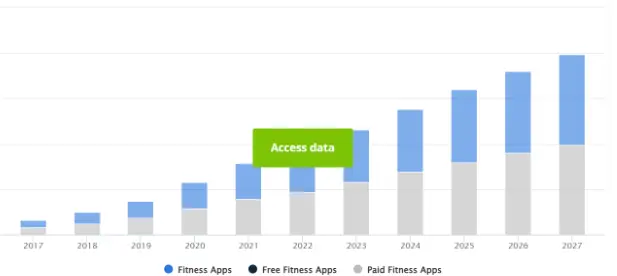On your smartphone, do you have a fitness app? In that case, we are not shocked. More and more people are becoming concerned about their health and body shape after the Apple Watch’s fitness craze in 2015. As a result, the market for fitness applications is still expanding.
Want to develop a fitness app and expand your market share? If so, you are headed in the right direction for success. You may discover how to make a fitness app, various monetization methods, and fitness app development costs from this post.
Fitness App Industry Perspectives
- In 2022, it is expected that the fitness apps market would generate US$15.49 billion in revenue.
- By 2027, the market is predicted to reach a value of US$33.04 billion, with revenue estimated to rise at a rate of 16.36% annually (CAGR 2022-2027).
- In 2022, there will be 8.67% of users, and by 2027, 12.21% of users are anticipated.
- It is anticipated that the average revenue per user (ARPU) will be US$23.47.
- Comparatively speaking, China will produce the majority of revenue ($4,645.00m in 2022).

How To Develop Your Fitness App In Four Easy Steps
Select the monetization strategy.
Choose your preferred revenue strategy among premium apps, in-app purchases, freemium, advertisements, or sponsored content.
Think about essential fitness app features
User profiles, Notifications, Social sharing, and Geolocation are the fundamental aspects of a fitness app.
Select the monetization strategy.
You must engage with a mobile development team to transform your company’s concept into a practical solution if you want to create your fitness app.
Develop applications through the exercise
You will require at least three developers to launch an app for iOS and Android, including backend developers and iOS and Android mobile app developers.
Types Of Fitness App Development
You must choose the kind of fitness app you wish to create. Users of fitness apps can access a variety of services, including goal tracking, sustaining motivation, socializing, and even fitness-related education. It’s like carrying around an inexpensive personal coach in your pocket.
Fit applications are divided into three categories of mobile healthcare apps based on their performance:
Activity monitoring programs
apps for nutrition and diet
Exercise and workout applications
Let’s examine each one in turn.
Activity Tracking Apps
The apps in this category may monitor a user’s physical activity, which essentially includes all of their daily activities. The number of steps walked, stairs climbed, hours of sleep, distance and speed run, and calories burned are all tracked by activity tracking apps.
The app displays user data on the app screen and typically can create charts, store routes on a map, and display user progress.
The HealthKit app is one illustration, which saves and maintains the information below:
- Body measurements and past weight
- Number Of Distance traveled
- Calories Burned
- Exercise Duration
- Favorite types of sports
Diet & Nutrition App
Diet and nutrition applications assist users in keeping track of their eating patterns, tracking calories consumed and burned, and managing water balance, body weight, and other factors. Users of a wide variety of diet applications can define individual objectives, make shopping lists, and even compile recipe collections.
Additionally, they might have some user-friendly functions or gamification components, like scoreboards or dieting competitions. Because they monitor your eating patterns, diet and nutrition apps can also be regarded as activity trackers. They differ in that they carry out more targeted activities.
One of the main examples is the My Fitness Pal Mobile App
Diet Monitor
The software gives users access to a vast library of foods and provides them with a target calorie intake based on their age, sex, and weight.
Community
Through the built-in MyFitnessPal forum, users may communicate with one another, exchange advice and suggestions, and share their problems.
Calorie Calculator
Each MyFitnessPal user keeps a digital journal that includes a calorie counter. Additionally, the software automatically saves and organizes user favorites for meals and snacks.
In general, people use diet apps to help them stay on a diet, measure their caloric consumption, and limit how much water and coffee they consume.
- Workout Apps
Thanks to a workout app, you can have a personal fitness coach on your smartphone. You can use that trainer wherever you want and carry it with you. In other cases, such as when using the Abs Workout app, you can even select a coach based on their name and degree of physical training.
We’ll use Sworkit and its features as an example.
Different programs
Users can select the body part they want to exercise initially. Full Body, Upper Body, Core Strength, Lower Body, Anything Goes, and Custom Workout are the available options.
Timer
You can select the number of minutes to spend performing each action while using the “Yoga, Cardio & More” or “Strength” options. The timer starts at five minutes. Then, from the workout screen, you may pause, skip exercises, and switch the sound on and off while working out.
Social Sharing
The software enables users to invite and challenge their friends by posting on Facebook and Twitter whenever they have finished their training.
How To Create A Fitness App Step-By-Step Guide Choose The Monetization Model
Paid apps
Users should purchase your software before using it. Depending on the type of application, mobile platform, and content you provide, the pricing of the app may change.
In-app purchases
If you want to make money from your free fitness app, you can persuade users to buy something from your app. You can provide a range of in-app purchases, such as premium content and healthy eating recipes.
Freemium
Basic software features are provided without charge to users, but they must pay for the full feature set. A premium subscription model is another name for this type of business strategy. Basic elements are free, while more complex exercise plans or private coaching are chargeable.
Ads
You can work with other fitness-related businesses and allow them to run promotional campaigns inside your fitness app. You might impose a commission based on the price per mile or click.
ad-supported material
This business approach includes collaborations with clubs and fitness experts. Your partners can contribute their expertise to your app and offer the app users helpful content.
Consider Basic Fitness App Features
Profiles of users
The purpose of nutrition applications is to assist users in achieving their objectives, such as healthy eating, weight loss, or even weight gain. To enable users to enter and update their physical attributes, such as current weight, height, and age, it is necessary to build a profile with personal data.
Notifications
The purpose of nutrition applications is to assist users in achieving their objectives, such as healthy eating, weight loss, or even weight gain. To enable users to enter and update their physical attributes, such as current weight, height, and age, it is necessary to build a profile with personal data.
Keep track of your exercise
Utilizing Apple’s HealthKit and Google Fit’s APIs to have access to the health and fitness information gathered on their platforms makes it simple to integrate your app with a smartphone’s sensors to implement the tracking function.
Sharing online
Connect with your users, let them share their accomplishments, and they’ll be eager to promote your software.
Geolocation
Looking at a map and seeing how many kilometers you have run, walked, or cycled gives you a huge boost in motivation.
Hire A Development Team
You must engage with a mobile development team to transform your company’s concept into a practical solution if you want to create your fitness app. Now take into account that hourly fees for developers vary considerably around the globe.
The average hourly rate for the US and Australian developers is $50.
West Europe starting around $45/hour
Eastern Europe: $30/ hour
India: $20 per hour
Inception Phase
Every development project begins with the product discovery phase. During this stage, you and your development team will:
- Establish the necessary task scope for your project.
- Make a project roadmap.
- Set the MVP budget and prepare your resources.
Technical Documentation
A technical writer creates the product’s technical specifications based on the needs of the client when creating the technical documentation for a fitness app. It contains all the necessary data for the fitness app developer to begin formulating solutions, including use cases, platforms, and other details.
Design
Our design team will need to dedicate roughly two months (160 hours) to developing a fantastic UX and UI for the fitness app. Once more, the price to construct your fitness software will depend on your needs; you may only demand standard functionality or you may also desire some unique micro-interactions.
Fitness App Development
You will require at least three developers to launch an app for iOS and Android, including backend developers and iOS and Android mobile app developers.
Quality Assurance
Testing and problem fixes take up a large amount of development time. QA engineers test not only the code for faults but also the project’s overall usability and if the features perform as planned.
Wrapping Up!
The creation of fitness applications might be difficult. However, now that you are aware of how to make a fitness app, we believe that it will be easy for you to estimate the cost of your project.
These summaries are provided:
Your solution should incorporate the top fitness app features, such as user accounts, goal-setting, actual activity tracking, and social elements.
The app might contain a feature for making custom workout programs.
It’s a good idea to collaborate with as many wearables manufacturers as you can (and cost-efficient)
Provide them with the opportunity to compete with or evaluate themselves against others; people love to do this.
When creating a fitness app, take into account gamification features to entice users to utilize it and tell their friends about it.




